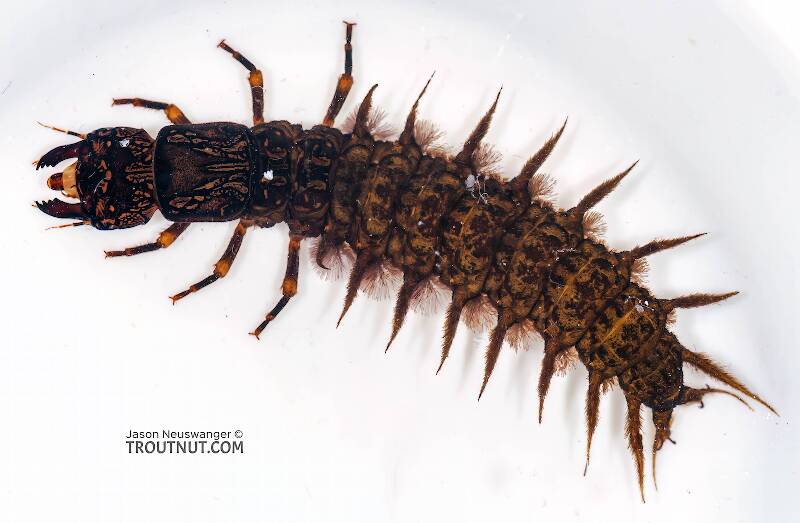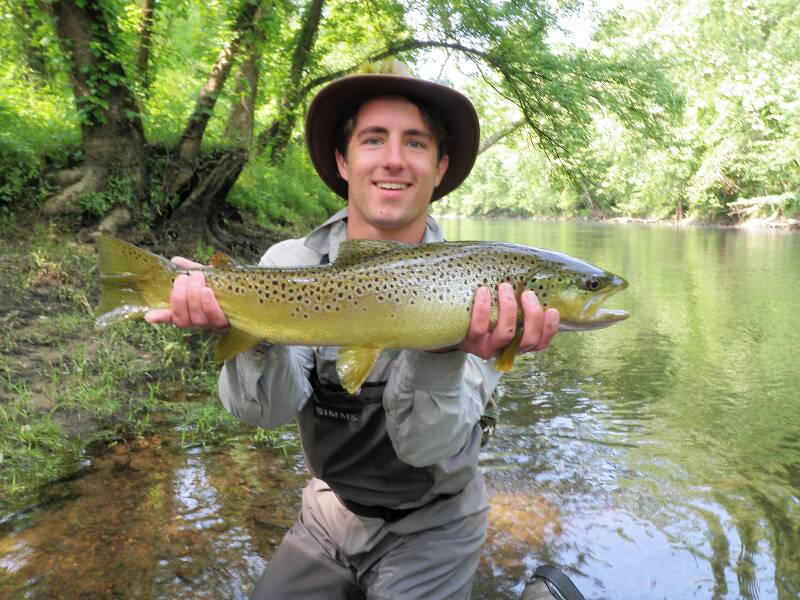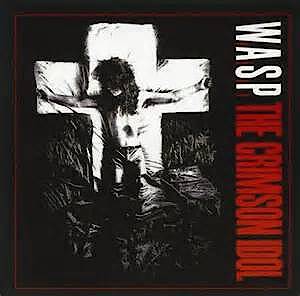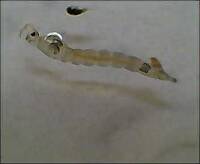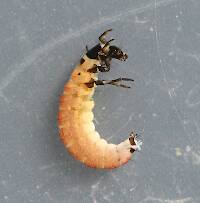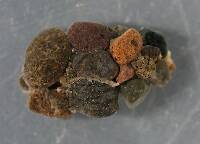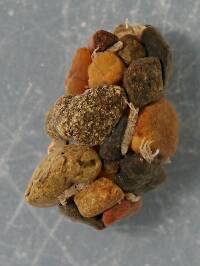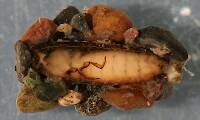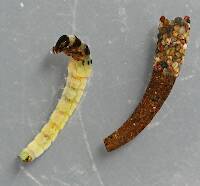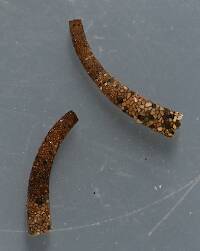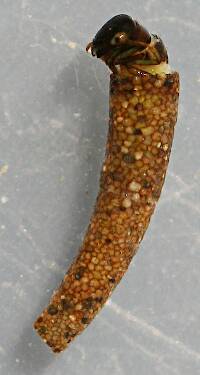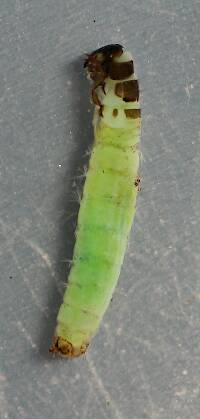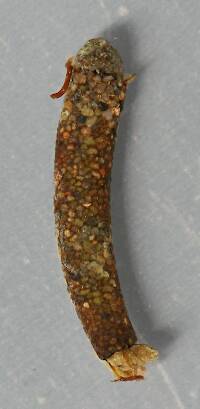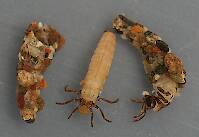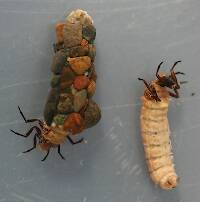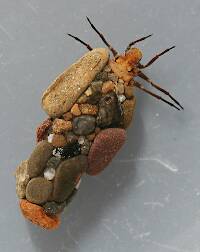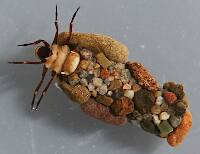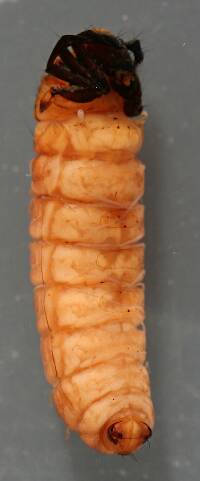
Hex Mayflies
Hexagenia limbata
The famous nocturnal Hex hatch of the Midwest (and a few other lucky locations) stirs to the surface mythically large brown trout that only touch streamers for the rest of the year.
Featured on the forum

Troutnut is a project started in 2003 by salmonid ecologist Jason "Troutnut" Neuswanger to help anglers and
fly tyers unabashedly embrace the entomological side of the sport. Learn more about Troutnut or
support the project for an enhanced experience here.
This topic is about the Hellgrammite Genus Corydalus
The largest and most well-known hellgrammites belong to this genus, although in my collecting experiences the fishflies of Nigronia seem to be more common in trout streams.Example specimen
Jesse on Jun 23, 2011June 23rd, 2011
What can anyone tell me about the Dobson Fly?
(General now guys, we don't have to go all scientific with it ha)!
(General now guys, we don't have to go all scientific with it ha)!
Most of us fish our whole lives..not knowing its not the fish that we are after.
http://www.filingoflyfishing.com
http://www.filingoflyfishing.com
Taxon on Jun 23, 2011June 23rd, 2011, 8:32 pm EDT
Hi Jesse-
Take a look at Dobsonfly Life Stage Characteristics.
If that is too "scientific" for you, try Wikipedia Dobsonfly.
Take a look at Dobsonfly Life Stage Characteristics.
If that is too "scientific" for you, try Wikipedia Dobsonfly.
Entoman on Jun 23, 2011June 23rd, 2011, 11:00 pm EDT
Nymphs are big and ugly. They can bite you (and it will hurt). Most common in shallow flowing water with cobble stones thats usually a little too warm for trout in the summer. Adults don't matter.
Kurt
Kurt
"It's not that I find fishing so important, it's just that I find all other endeavors of Man equally unimportant... And not nearly as much fun!" Robert Traver, Anatomy of a Fisherman
Adirman on Jun 24, 2011June 24th, 2011, 6:15 am EDT
The adult kinda looks like a stone fly to me!! What color is the adult?
Entoman on Jun 24, 2011June 24th, 2011, 9:53 am EDT
Usually brown.
"It's not that I find fishing so important, it's just that I find all other endeavors of Man equally unimportant... And not nearly as much fun!" Robert Traver, Anatomy of a Fisherman
PaulRoberts on Jun 24, 2011June 24th, 2011, 10:18 am EDT
I wrote an article for American Angler Jul/Aug '99, with pics of all stages, life history and habits, and a unique killer larval pattern -one that has taken more out-sized browns for us than any other. My images are all transparencies otherwise I'd post them for you. The pattern is a weighted woolly bugger in Corydalid colors and designed to writhe, and to keep a grip on big browns -an issue with some head weighted patterns.
Here's a line from the article describing the pattern:
"Over the course of several seasons, the UltHelgrammite has consistently attracted large trout. On one memorable occasion following an early spring spate, the fly conjured up 16 browns --including a 15-incher, four 17's, and a 19-incher --from a public freestone creek. All these fish came from a stretch of water that I had already worked over with a big black stonefly pattern."
When I clear some time I'll post a pic of the pattern. If you can find the article it shows how to tie it. It did not give the correct hook style though -the eds couldn't find it in a fly catalog apparently. It's the Mustad #37140 and it's not a fly-tying hook but a "Kahle" style used for baitfishing -esp catfish. Great hook with a useful bend that also really holds.
Here's a line from the article describing the pattern:
"Over the course of several seasons, the UltHelgrammite has consistently attracted large trout. On one memorable occasion following an early spring spate, the fly conjured up 16 browns --including a 15-incher, four 17's, and a 19-incher --from a public freestone creek. All these fish came from a stretch of water that I had already worked over with a big black stonefly pattern."
When I clear some time I'll post a pic of the pattern. If you can find the article it shows how to tie it. It did not give the correct hook style though -the eds couldn't find it in a fly catalog apparently. It's the Mustad #37140 and it's not a fly-tying hook but a "Kahle" style used for baitfishing -esp catfish. Great hook with a useful bend that also really holds.
JOHNW on Jun 24, 2011June 24th, 2011, 12:35 pm EDT
Nymphs are big and ugly. Adults don't matter.
Kurt
Kurt,
I'll kindly disagree on the statement about the adults. I have quite a few splendid nights skittering large stimmulator type patterns on what used to be a world class smallmouth fishery.
Jesse,
The dobson fly larva also goes by the common name of hellgramite. One of the fiercest live baits I've ever used (when I used such things). Don't mistake them for fishfly larva however.
In either case a slender heavily segmented wooly bugger in neutral colors can turn the trick for the larval stage.
JW
"old habits are hard to kill once you have gray in your beard" -Old Red Barn
Entoman on Jun 24, 2011June 24th, 2011, 1:21 pm EDT
Hi JW,
In keeping with Jesse's request, I kept my comments sparse and very general. There are always exceptions to any generality, but I do think that occurances of adult Dobsonflys being available to trout in fishable numbers is rare enough that they can be considered unimportant from a practical standpoint. Does that mean if I ever run into a situation that proves the exception, I won't be prepared? Not on your life! I too carry some large nondescript fuzzies for just such an occasion.:) Can't think of any fishing more fun than throwing big bushies to slashing fish at last light.
BTW - You're right! Fierce is the word...
Regards,
Kurt
In keeping with Jesse's request, I kept my comments sparse and very general. There are always exceptions to any generality, but I do think that occurances of adult Dobsonflys being available to trout in fishable numbers is rare enough that they can be considered unimportant from a practical standpoint. Does that mean if I ever run into a situation that proves the exception, I won't be prepared? Not on your life! I too carry some large nondescript fuzzies for just such an occasion.:) Can't think of any fishing more fun than throwing big bushies to slashing fish at last light.
BTW - You're right! Fierce is the word...
Regards,
Kurt
"It's not that I find fishing so important, it's just that I find all other endeavors of Man equally unimportant... And not nearly as much fun!" Robert Traver, Anatomy of a Fisherman
PaulRoberts on Jun 24, 2011June 24th, 2011, 2:58 pm EDT
Don't mistake them for fishfly larva however.
My article referred to fishflies. I would think the two would be virtually interchangeable, as far as a fly patterns go, with fishflies more apt to be found in trout water. What are you meaning -curious.
PaulRoberts on Jun 24, 2011June 24th, 2011, 6:19 pm EDT
Entoman on Jun 24, 2011June 24th, 2011, 6:29 pm EDT
I was gonna ask you to post the article if you had the time. Cool fly Paul... In smaller sizes, a really good damselfly? The sparse yet spikey hackle fibers aught to cause a good ammount of turbulence. That should really make the marabou flutter yet doesn't mess up the silouette.
"It's not that I find fishing so important, it's just that I find all other endeavors of Man equally unimportant... And not nearly as much fun!" Robert Traver, Anatomy of a Fisherman
PaulRoberts on Jun 25, 2011June 25th, 2011, 4:29 am EDT
It's the hook, with lead eyes on top, and tail originating up at the bend, the sickle shaped shank hanging below --Photo #2 shows it-- that makes it unstable causing it to swing side to side. The hackle just goes along for the ride. I also tie it in a sculpin -the UltSculpin.
The Little UltHelgrammite is a Sialid larva pattern that would make a good damsel, but I haven't done it yet. There's a pic of that too in the article -it uses bead chain instead of lead eyes.
BTW I don't name most of my concoctions. But a few designs are original enough and effective enough to remember.
Curious Jesse -How did Dobson's catch your fancy? Are you thinking about the adults? I've seen them at night, but never fished one.
As the photo above shows, pupation occurs out of the water. And adults are supposed to lay eggs above water, on an overhang from which the eggs drop in. Thus I, like most others I suppose, haven't considered the adults worth imitating. Have you seen something interesting?
When night fishing for browns I've found them responsive to almost anything dragged across the surface -selectivity going out the window -at least on smaller waters. A buddy introduced his night fly to me -a deer hair mouse trimmed top and bottom until it's almost flat -like a potato chip lol, which makes it light in weight and easier to cast on trout tackle (5-6wt) yet still provides a big profile. Mine was always a "Woodchuck Caddis" derivative with a clipped hackle body that skates really well and is snagless -great addition to a night fly. It makes a good moth or large stonefly pattern (many are night egg-layers) or here in the West, a good Arctopsyche pattern (also a night layer). This fly could be tied longer to give a Dobson silhouette, but I don't know how the adults behave -on the water, if they ever get there. They don't look like they are built to operate on the water. Anyone know?
The larvae can be GREAT -where they mix with trout -usually down the watershed a ways where, as Kurt mentions, trout habitat becomes marginal. Such areas are often where the largest browns in the watershed exist though. The fishflies I've made darn good use of live in strong riffles. along with stoneflies. They can be collected under the larger substrate pieces and seem to only become available to fish when they are torn free by strong spates, and also presumably when they move to shore to pupate. I've seen the larvae exposed along silty shoreline and assumed they were moving to pupate. Probably this occurs mostly at night though, but I dunno. I first began tying the larval patterns after recovering them from trout stomachs. The trout in those waters obviously recognized them and they worked outside the spate periods too.
The Little UltHelgrammite is a Sialid larva pattern that would make a good damsel, but I haven't done it yet. There's a pic of that too in the article -it uses bead chain instead of lead eyes.
BTW I don't name most of my concoctions. But a few designs are original enough and effective enough to remember.
Curious Jesse -How did Dobson's catch your fancy? Are you thinking about the adults? I've seen them at night, but never fished one.
As the photo above shows, pupation occurs out of the water. And adults are supposed to lay eggs above water, on an overhang from which the eggs drop in. Thus I, like most others I suppose, haven't considered the adults worth imitating. Have you seen something interesting?
When night fishing for browns I've found them responsive to almost anything dragged across the surface -selectivity going out the window -at least on smaller waters. A buddy introduced his night fly to me -a deer hair mouse trimmed top and bottom until it's almost flat -like a potato chip lol, which makes it light in weight and easier to cast on trout tackle (5-6wt) yet still provides a big profile. Mine was always a "Woodchuck Caddis" derivative with a clipped hackle body that skates really well and is snagless -great addition to a night fly. It makes a good moth or large stonefly pattern (many are night egg-layers) or here in the West, a good Arctopsyche pattern (also a night layer). This fly could be tied longer to give a Dobson silhouette, but I don't know how the adults behave -on the water, if they ever get there. They don't look like they are built to operate on the water. Anyone know?
The larvae can be GREAT -where they mix with trout -usually down the watershed a ways where, as Kurt mentions, trout habitat becomes marginal. Such areas are often where the largest browns in the watershed exist though. The fishflies I've made darn good use of live in strong riffles. along with stoneflies. They can be collected under the larger substrate pieces and seem to only become available to fish when they are torn free by strong spates, and also presumably when they move to shore to pupate. I've seen the larvae exposed along silty shoreline and assumed they were moving to pupate. Probably this occurs mostly at night though, but I dunno. I first began tying the larval patterns after recovering them from trout stomachs. The trout in those waters obviously recognized them and they worked outside the spate periods too.
JOHNW on Jun 25, 2011June 25th, 2011, 2:22 pm EDT
Don't mistake them for fishfly larva however.
My article referred to fishflies. I would think the two would be virtually interchangeable, as far as a fly patterns go, with fishflies more apt to be found in trout water. What are you meaning -curious.
PAul,
More from the ID perspective. I would agree that in terms of pattern they are pretty much interchangable with the fishfly being more trout relevant.
I was once at a steamside course presented by Greg Hoover from Penn State. He had several samples he had seined from the stream and every single one of us jumped on one as being a Hellgramite. You guessed it we were all wrong and it was a fish fly larva. Greg went on to indicate he felt that the fishfly was one of the more neglected insects when it came to those of us who ply the waters with the long rod.
Kurt,
Good point! I don't know that I have ever targeted trout with the dobsonfly skitter. Big smallies however are a sucker for it.
JW
"old habits are hard to kill once you have gray in your beard" -Old Red Barn
Jesse on Jun 25, 2011June 25th, 2011, 2:54 pm EDT
Guys thank you for the already great responses. Ive been doing a little research myself and find that everything you guys are saying is true, and more so.. To answer your question Paul the Dobson Fly has been of recent concern to me. Lately ive been trying new things and one of them happens to be some night fishing in area's i normally wouldn't. Well as i was knee deep in cool water and surrounded by pitch darkness, i heard this outlandish buzzing right next to me. I looked to my right, and there it was just fluttering next to me almost as it was a small helicopter looking for its landing strip. I was honestly a little freaked out by its "bigger than normal' buggy body. I knew it wasn't a moth and it seemed way to big to be a stonefly. I went home and did some research, asked around and have been doing some more night excursions. Despite the flies natural stages to craw out of water in its pupal stage and lay eggs not directly on the water, when they aren't flying around everywhere at night, the fish aren't rising as fiercly. The fly kind of intrigues me! Thanks again guys!
Most of us fish our whole lives..not knowing its not the fish that we are after.
http://www.filingoflyfishing.com
http://www.filingoflyfishing.com
PaulRoberts on Jun 26, 2011June 26th, 2011, 5:49 am EDT
John, I hear you on the name issue with entomologists. I too call the fishfly larvae "hellgrammites", it being a common name and all. And I've been corrected by entomologists, although I never understood why that common name is affixed to only one of several creatures so closely related and very alike in appearance and habits. If someone can tell me the reason, I'll stop lumping those larvae as "hellgrammites". And will re-name my fly pattern the "UltFishFlyLarva" or UltChauliodinae. lol
Jesse, Love the vignette of your encounter. Here's a paragraph from my article (before it was butchered by the editor prior to printing); It appears we've both met them in similar circumstances:
"They are so ugly in fact that they’ve been classified into their own order –called the Megaloptera, which means “gigantic wing”. If you ever become a night fisher, you may just find out where this name comes from some dark night. It’s enough to send you back to casting to sippers in the warm glow of daylight. But, once again, and with all due respect, this is not an article about sippers..."
BTW Jesse -sounds like you are hunting in the right places. ;) In narrowing down water/tracking fish, pay attention to night/early AM water temps. And think "water volume".
Jesse, Love the vignette of your encounter. Here's a paragraph from my article (before it was butchered by the editor prior to printing); It appears we've both met them in similar circumstances:
"They are so ugly in fact that they’ve been classified into their own order –called the Megaloptera, which means “gigantic wing”. If you ever become a night fisher, you may just find out where this name comes from some dark night. It’s enough to send you back to casting to sippers in the warm glow of daylight. But, once again, and with all due respect, this is not an article about sippers..."
BTW Jesse -sounds like you are hunting in the right places. ;) In narrowing down water/tracking fish, pay attention to night/early AM water temps. And think "water volume".
Entoman on Jun 27, 2011June 27th, 2011, 11:08 am EDT
Hi Paul,
John is right that the larvae of Fishflys and Dobsonflys are different critters and that they shouldn't be confused, and you are right that for better or worse, both share the same common name in the larval stage by the vast majority. Large Megalopterans are Hellgrammites and that's just the way it is. Kinda like the dilemma created by the common name Blue Winged Olive used for several different mayfly species. Since your fly is an effective imitation of both anyway, I think your use of the shared common name is the way to go. Looks like a hellgrammite to me!:)
Suggestions from well meaning souls on a different use of common names to avoid confusion is one thing, but to accuse someone of error is quite another. Like correcting latin pronunciations - it's bad form. In your case, they were wrong to boot, which is funny.
We should allow science to stay out of the common name business. A humorous example is the use of the name "Salfly" to describe Little Yellow Stones or Yellow Sallies. Now entomologists have their reasons for labeling them so, but I don't know ANYBODY that used the term "Salfly" until it started to show up in scientific papers. Common names are supposed to be well, common... As in "common usage"? That's why we all use Latin names accompaning the common for determinations or if there is a possibility for confusion.
Here's another example of many in our fraternity engaging in the silly practice of looking to science for common names, but taking silliness a step further by botching the attempt. Many Westerners are running around calling all smaller olivaceous Drunellas "Flavs". Taking an accurate scientific name for a single species, shortening it to a nickname and then applying it to a host of other species is absurd on it's face. It may be absurd and an assault on the English language and common sense (not to mention any semblance of the esthetic), but not an error. Regrettably, "Flav" has become an oft used common name.
Human beings are funny creatures.:)
Regards,
Kurt
John is right that the larvae of Fishflys and Dobsonflys are different critters and that they shouldn't be confused, and you are right that for better or worse, both share the same common name in the larval stage by the vast majority. Large Megalopterans are Hellgrammites and that's just the way it is. Kinda like the dilemma created by the common name Blue Winged Olive used for several different mayfly species. Since your fly is an effective imitation of both anyway, I think your use of the shared common name is the way to go. Looks like a hellgrammite to me!:)
And I've been corrected by entomologists
Suggestions from well meaning souls on a different use of common names to avoid confusion is one thing, but to accuse someone of error is quite another. Like correcting latin pronunciations - it's bad form. In your case, they were wrong to boot, which is funny.
We should allow science to stay out of the common name business. A humorous example is the use of the name "Salfly" to describe Little Yellow Stones or Yellow Sallies. Now entomologists have their reasons for labeling them so, but I don't know ANYBODY that used the term "Salfly" until it started to show up in scientific papers. Common names are supposed to be well, common... As in "common usage"? That's why we all use Latin names accompaning the common for determinations or if there is a possibility for confusion.
Here's another example of many in our fraternity engaging in the silly practice of looking to science for common names, but taking silliness a step further by botching the attempt. Many Westerners are running around calling all smaller olivaceous Drunellas "Flavs". Taking an accurate scientific name for a single species, shortening it to a nickname and then applying it to a host of other species is absurd on it's face. It may be absurd and an assault on the English language and common sense (not to mention any semblance of the esthetic), but not an error. Regrettably, "Flav" has become an oft used common name.
Human beings are funny creatures.:)
Regards,
Kurt
"It's not that I find fishing so important, it's just that I find all other endeavors of Man equally unimportant... And not nearly as much fun!" Robert Traver, Anatomy of a Fisherman
Jesse on Jun 27, 2011June 27th, 2011, 4:59 pm EDT
Paul you got it man and im trying to get on the right track haha. Oh and as far as out encounters..good stuff!
Most of us fish our whole lives..not knowing its not the fish that we are after.
http://www.filingoflyfishing.com
http://www.filingoflyfishing.com
Troutnut on Jun 28, 2011June 28th, 2011, 1:24 am EDT
Since fishfly larvae are so similar to dobsonfly larvae (the "real" hellgrammites), but are just slightly less extreme, I propose a new common name for fishfly larvae: heckgrammites.
Jason Neuswanger, Ph.D.
Troutnut and salmonid ecologist
Troutnut and salmonid ecologist
PaulRoberts on Jun 28, 2011June 28th, 2011, 6:26 am EDT
LOL! What the heck! It's a common name after all.
Entoman on Jun 28, 2011June 28th, 2011, 7:41 am EDT
Jason -
Ha! very good. Put it to music and heck, it might win a Grammy....
Ok, I know. But the difference between grin and groan is only a vowel sound.
Kurt
Ha! very good. Put it to music and heck, it might win a Grammy....
Ok, I know. But the difference between grin and groan is only a vowel sound.
Kurt
"It's not that I find fishing so important, it's just that I find all other endeavors of Man equally unimportant... And not nearly as much fun!" Robert Traver, Anatomy of a Fisherman
Quick Reply
Related Discussions
Topic
Replies
Last Reply
5
Jun 28, 2011
by PaulRoberts
by PaulRoberts
2
Apr 7, 2012
by Crepuscular
by Crepuscular
4
Oct 29, 2014
by Millcreek
by Millcreek
16
May 20, 2008
by Shawnny3
by Shawnny3



